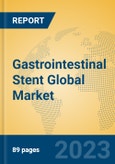Regional Analysis
- North America: The U.S. leads with high cancer screening rates, while Canada focuses on chronic GI care.
- Europe: Germany, France, and the UK drive demand due to advanced endoscopy adoption.
- Asia Pacific: China and India see growth from rising cancer prevalence, while Japan emphasizes precision stenting.
- Rest of the World: Brazil expands minimally invasive access, and the Middle East invests in GI health tech.
Application Analysis
- Gastrointestinal Cancer: Expected growth of 5.0%-6.8%, driven by oncology needs. Trends focus on drug-eluting stents.
- Biliary Disease: Projected growth of 4.7%-6.5%, linked to gallstone complications. Developments emphasize anti-migration features.
- Colorectal Cancer: Anticipated growth of 4.9%-6.7%, suited for obstruction relief. Advances prioritize durability.
- Stomach Cancer: Expected growth of 4.6%-6.4%, driven by gastric cases. Trends lean toward biodegradable options.
- Others: Projected growth of 4.5%-6.3%, covering niche conditions. Innovations focus on patient comfort.
Type Analysis
- Biliary Stent: Expected growth of 4.8%-6.6%, valued for biliary relief. Trends highlight self-expanding designs.
- Esophageal Stent: Projected growth of 5.0%-6.8%, key for dysphagia. Advances focus on anti-reflux features.
- Colonic Stent: Anticipated growth of 4.7%-6.5%, suited for colorectal use. Innovations emphasize flexibility.
- Pancreatic Stent: Expected growth of 4.6%-6.4%, driven by pancreatitis. Trends lean toward drainage efficiency.
- Duodenal Stent: Projected growth of 4.5%-6.3%, key for obstruction. Advances prioritize placement accuracy.
Key Market Players
Leading firms include Boston Scientific Corporation, advancing with WallFlex; Cook Medical, offering stent solutions; Olympus Corporation, enhancing endoscopy; Medtronic, supporting GI tools; Merit Endotek, targeting stenting; ELLA, innovating biodegradable stents; CONMED Corporation, focusing on GI care; Cantel Medical Corporation, boosting endoscopy; Hobbs Medical, developing stents; and Gore Medical, enhancing durability.Porter's Five Forces Analysis
- Threat of New Entrants: Moderate, due to regulatory and technological barriers, though niche innovators can enter.
- Threat of Substitutes: Low, as GI stents offer unique minimally invasive relief with no direct alternatives.
- Bargaining Power of Buyers: Moderate, with facilities seeking effective, cost-efficient stents, though specialized needs limit options.
- Bargaining Power of Suppliers: Low, with multiple material suppliers available.
- Competitive Rivalry: High, with competition on innovation, stent design, and endoscopic compatibility.
Market Opportunities and Challenges
Opportunities
- GI cancers (1.93 million colorectal cases) and chronic diseases drive demand.
- Aging populations (one in six over 60 by 2030) increase needs, while biodegradable and drug-eluting stents enhance outcomes.
- Screening programs and insurance coverage boost adoption.
Challenges
- High costs of advanced stents limit access in low-income regions.
- Regulatory delays for new designs slow growth.
- Limited GI specialists in rural areas restrict expansion.
Market News:
- In June 2024, Boston Scientific Corporation agreed to acquire Silk Road Medical, Inc., enhancing minimally invasive GI solutions.
This product will be delivered within 1-3 business days.
Table of Contents
Companies Mentioned
- Boston Scientific Corporation
- Cook Medical
- Olympus Corporation
- Medtronic
- Merit Endotek
- ELLA
- CONMED Corporation
- Cantel Medical Corporation
- Hobbs Medical
- Gore Medical








